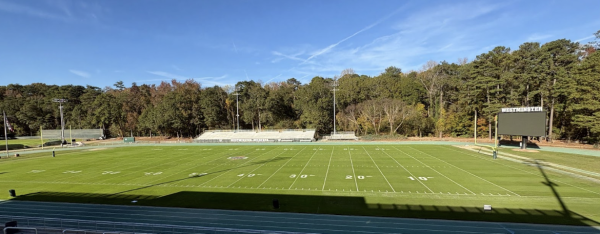Westminster athletic complex floods during storm
After heavy rain on Sept. 17, students received exciting news when they saw almost the entire athletic complex had flooded. The flooding was largely concentrated in the athletic complex, the lower Turner parking lot, and along Kosh trail, and receded by the evening.
The athletic complex is built on a floodplain, which means that flooding will often occur during heavy rainstorms as a result of its proximity to Nancy Creek. Large amounts of rainfall upstream and water coming down from the rest of campus around Askew, Pressly, Campbell, and Hawkins further contributes to the flooding.
The flooding happens “about once or twice per year,” said facilities operations and projects manager, Foroud Azimi. Because the flooding occurs commonly, Westminster’s facilities staff and athletic teams know how to “work with it and deal with it,” said athletic director Tim Downes, meaning the flooding typically does not have a long-term impact on Westminster’s campus and teams.
Despite measures to prevent it, the flooding did temporarily affect the football and cross country teams. The varsity football team was forced to cancel an intersquad scrimmage, but the flooding had minimal consequences.
“The scrimmage didn’t need to be made up,” said varsity football player Jaden Owens. “Thanks to the facilities team, we were back on the field the next day.”
As a result of the flooding, the boys cross country team had to move an interval workout from the track and trail to the back fields.
“We had to be a little creative about where we were running for the next few days because of the debris on the track,” said senior cross country captain Ryan Hockstein. “It was a good experience running in adverse conditions which is something the team really needs because they never know what the conditions will be like at a meet.”
The girls cross country team canceled practice the day of the flooding and, like the boys, had a challenge finding places to run afterward. The flooding affects both cross country teams in ways beyond cancelling practice.
“Erosion is really the problem, given the effects of the flooding over many years compounding to chip away at the banks of Nancy Creek and Kosh trail,” said boys cross country coach Joe Tribble.
While flooding posed immediate problems for access to underwater areas, the water receded from the affected areas the evening of the flooding and the cleanup process started the following morning. This behavior of the water means the main problem with the flooding results from the water carrying silt wherever it goes.
“All the silt from the river does cause some problems, particularly on the track and baseball fields,” said Downes. “This means that the facilities department has to go out and clean it up.”
The cleanup process took the facilities department a few days to complete with power washing and cleaning off the track taking twelve hours, another six hours spent cleaning the lower Turner parking lot, and additional time taken to repair the cross country trail.
As some students may know, a popular piece of Westminster lore is the picture of former assistant headmaster and Westminster legend Scoot Dimon fishing from his canoe on a flooded Westminster football field in an event he declared “the Great Flood of ‘98” in his Instagram caption. However, Downes revealed a lesser-known story about a past flood, when a Marist blocking dummy was found on campus. As both Westminster and Marist are built next to Nancy Creek, the flooding took the blocking dummy from Marist and carried it all the way to Westminster.
“The blocking dummy got tired of the dress code at Marist and requested a job transfer that the flood fulfilled,” said Downes.
The flooding has affected Westminster’s campus since its founding because of Nancy Creek. During heavy rain, the creek floods down in the lower parking lot first and then pushes in two areas on adjacent sides of the visiting bleachers. By monitoring upstream water levels and seeing when they surpass a certain threshold, Westminster can tell when flooding will occur. This advance warning gives Westminster time to minimize the flooding’s impact by doing things such as clearing out the parking lot and giving the facilities department time to prepare a response.
However, despite the advance warning, Westminster cannot stop the flooding, but as part of the new construction on campus, they have taken steps to prevent it.
“The upgrading of the storm-water management systems which took place as part of the construction efforts over the last year may have been the reason why the water drained so quickly this year,” said Azimi.
The reason Westminster cannot stop the flooding entirely is because doing so would involve altering the floodplain the athletic complex stands on. Altering the floodplain would consequently increase flooding conditions elsewhere, which Article VI of the City of Atlanta Code of Ordinances, regarding flood-area regulation, prohibits.
Finally, a pressing concern on the mind of many students is if they can swim or kayak in the field when it floods. Unfortunately, Downes recommends against swimming during flooding because of the questionable quality of the standing water, and Azimi would like to remind students that no kayaks, canoes, boats, or yachts are allowed on the field.
Despite this crushing blow to the nautical exploration of “Lake Westminster,” students can still count themselves lucky because only at Westminster are they able to witness the amazing event of a lake popping up in the middle of campus.


